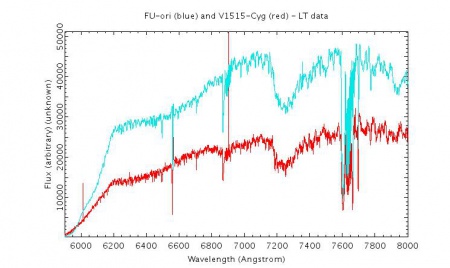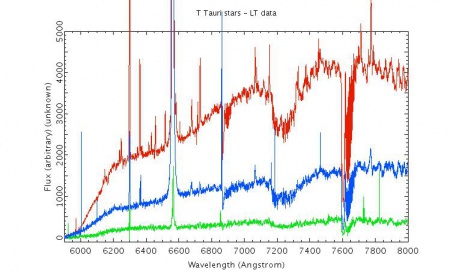Difference between revisions of "Triggers:TTau"
Chris.davis (talk | contribs) |
Chris.davis (talk | contribs) |
||
| (2 intermediate revisions by the same user not shown) | |||
| Line 8: | Line 8: | ||
T Tauri stars are known to vary on periods of days, weeks, and months. Causes include episodic accretion events, warped disk occultations, the transit of dark spots in the photosphere. | T Tauri stars are known to vary on periods of days, weeks, and months. Causes include episodic accretion events, warped disk occultations, the transit of dark spots in the photosphere. | ||
| − | == Relevant characteristics of TTSs | + | == Relevant characteristics of TTSs == |
* irregular and quasi-periodic variations | * irregular and quasi-periodic variations | ||
| Line 21: | Line 21: | ||
* Strong forbidden emission lines; [OI], [SII], [NII], etc. | * Strong forbidden emission lines; [OI], [SII], [NII], etc. | ||
* Lithium absorption | * Lithium absorption | ||
| − | * P Cygni profiles | + | * P Cygni profiles (due to outflowing gas); inverse P Cygni in some cases |
| − | == FU-Ori | + | == FU-Ori, EX-Ori and other outbursts == |
Some young pre-main-sequence stars have exhibited quite drastic episodic variations. | Some young pre-main-sequence stars have exhibited quite drastic episodic variations. | ||
Latest revision as of 15:10, 26 July 2013
T Tauri stars and other young variables and transients
T Tauri type stars (TTSs) are very young (<math> <10^7 </math> yr), low mass (<math> <3 M^{}_\odot </math>), pre-main sequence objects Appenzeller & Mundt 1989. They are optically visible (spectral type F,G,K,M) and their spectral energy distributions possess a modest excess in the near- and mid-IR, although the slope of their SED in the IR is still negative. Classical TTSs (Class II Young Stellar Objects) exhibit strong forbidden emission lines from ionised oxygen, sulphure, iron, etc., and they are often associated with Herbig-Haro jets; weak-lined TTSs (Class III YSOs) are essentially line-free.
Class I YSOs possess a very strong IR excess (flat or positive spectral indices), are embedded, and are brighter in the near- and mid-IR bands. There is some statistical evidence that Class I YSOs - protostars - are the progenitors of TTSs; they are typically less abundant than Class II YSOs, are more likely to coincide with dark clouds and molecular cores, and may be much younger (< 100,000 yr).
T Tauri stars are known to vary on periods of days, weeks, and months. Causes include episodic accretion events, warped disk occultations, the transit of dark spots in the photosphere.
Relevant characteristics of TTSs
- irregular and quasi-periodic variations
- high amplitude (up to 5 mag)
- may have a phase of quiescence (see figure)
- absolute magnitude range: M_V=? to ? mag
- typically do not require a trigger, but watch list of T Tauris would be useful
Spectral features
- Strong Balmer emission lines
- Strong forbidden emission lines; [OI], [SII], [NII], etc.
- Lithium absorption
- P Cygni profiles (due to outflowing gas); inverse P Cygni in some cases
FU-Ori, EX-Ori and other outbursts
Some young pre-main-sequence stars have exhibited quite drastic episodic variations. 1-3 mag eruptions have been observed in several objects (e.g. EX Lup, DR Tau), while more spectacular eruptions corresponding to a brightening of 3-6 mag have been measured in FU Orionis type variables (FU-ors). A dozen young stars are now characterised as FUors. Most have been observed to rise 3-5 mag in brightness in less than one year; V1515 Cyg is the only known example to require a decade to rise to visual maximum. Note, however, that the historical light curves for many systems are poorly documented.
Below are sample optical spectra of classical T Tauri stars and two FU-ori type eruptive variables.



